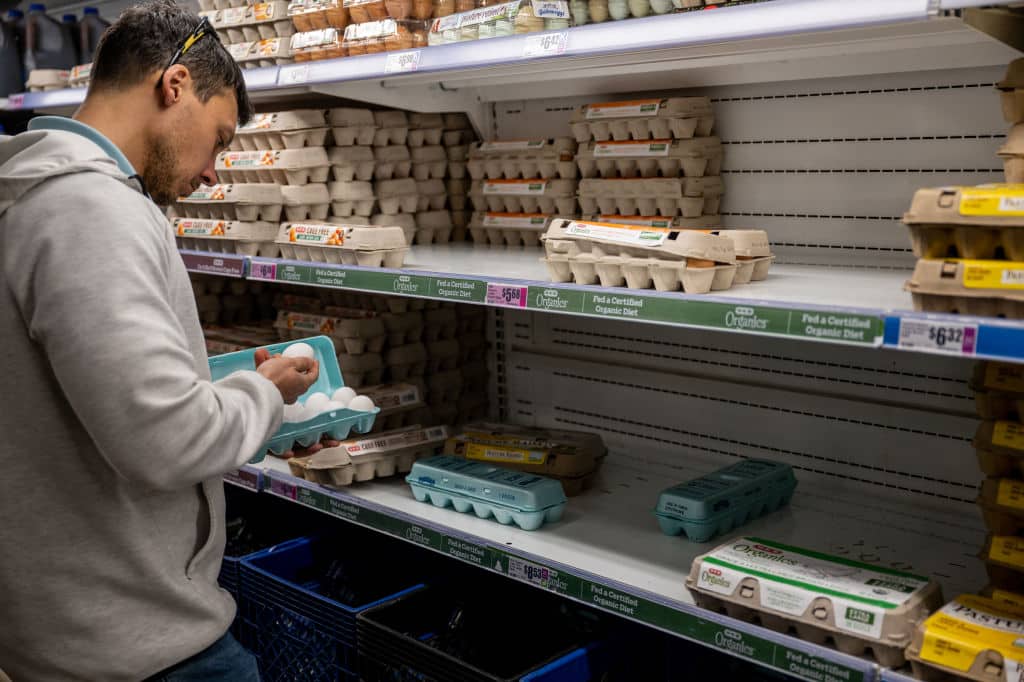TOPLINE
Lettuce and eggs have seen the highest price increases among all food and drink items through the start of 2024, according to the latest six-month data from the Bureau of Labor Statistics, while citrus fruits have plummeted in price after recovering from a tough 2023.
KEY FACTS
Lettuce prices increased 10.3% from last November through May, according to consumer price index data, in part because of low supply as a result of poor weather for growing in California and Arizona, Miguel Gómez, food and agricultural economist at Cornell University, told Forbes.
Lettuce is tricky as it can largely only grow in western states struggling with water supply and it’s labor-intensive, meaning it’s more expensive to produce, especially in states like California that have raised the minimum wage and are potentially passing that cost to consumers, Colorado State University professor Dawn Thilmany said.
Following lettuce, eggs had the biggest increase at 9.5%, which Gómez said may be the result of suppliers overcorrecting after prices jumped from quite high to quite low last year, and Thilmany said could still be tied to recovering from what avian influenza did to laying houses and supply in recent years.
Citrus fruits, oranges and tangerines, and apples were three of the five items with the highest decreases, something Gómez said is because citrus growth has been good in the U.S. this year, so there’s an excess domestic supply on top of what is already being imported from other countries—reversing a rough 2023 for citrus.
Loading...
Thilmany echoed Gómez’s read on the decreased prices of some fruits, adding there were “really good growing conditions” for winter crops like citrus that could result in the lower costs.
FOOD AND DRINK ITEMS WITH BIGGEST PRICE INCREASES (NOVEMBER TO MAY)
- Lettuce, 10.3% increase
- Eggs, 9.5% increase
- Tomatoes 3.9% increase
- Other condiments, 3.9% increase
- Other beverages including tea, 3.2%
FOOD AND DRINK ITEMS WITH BIGGEST PRICE DECREASES
- Citrus fruits, 7.8% decrease
- Apples, 6.2% decrease
- Other uncooked poultry including turkey, 4.1% decrease
- Oranges, including tangerines, 3.9% decrease
- Potatoes, 3.6% decrease
BIG NUMBER
0.9%. That was the overall increase for food and beverage prices in U.S. cities from November to May. Inflation stood at 1.7% for all items generally.
WHAT TO WATCH FOR
When asked what consumers can look forward to in the back half of the year, Thilmany said shoppers might need to appropriately set their expectations. “I think people are gonna have to have an epiphany that we’re not going back to those prices,” she told Forbes, “but we are going to quit seeing this continued escalation.”
SURPRISING FACT
Just four foods saw no price change in the last six months, according to the CPI data: cereals and bakery products, bread, poultry and food at elementary and secondary schools. Gómez told Forbes bakery products and cereal have likely stayed steady because markets for the key ingredients, like grain crops, have remained “relatively stable” through the first half of the year.
KEY BACKGROUND
Following years of high inflation tied partly to the COVID-19 pandemic, inflation started to cool last year into this year—including for usually volatile food prices. Overall year-over-year inflation stood at 3.3% in May, an improvement from the same month in 2023 (4%) and 2022 (8.6%). Last year, the U.S. saw factors like supply chain issues and wholesale prices ease compared to 2022, which saw a 9.9% overall increase in food prices. 2023 had an overall increase of just 5.8%, according to the U.S. Department of Agriculture. Eggs were a key element of increased inflation that Americans were suffering from, as the median cost of a dozen eggs in the U.S. last January was $4.25—more than twice what it was a year prior—because of the avian flu making a dent on supply. Heading into the November election, food inflation is top-of-mind for many voters: A recent Ipsos poll of swing states voters found a plurality of voters believed inflation and increasing costs was the most important issue facing the country. Despite concerns, the USDA predicts food inflation will continue to decelerate throughout the year and see a moderate total increase of around 2.2%. Inflation for food at home like groceries was just 1% higher in May than the previous year, and food away from home like restaurant purchases increased about 4% compared to the previous year, according to the consumer price index.
Loading...
